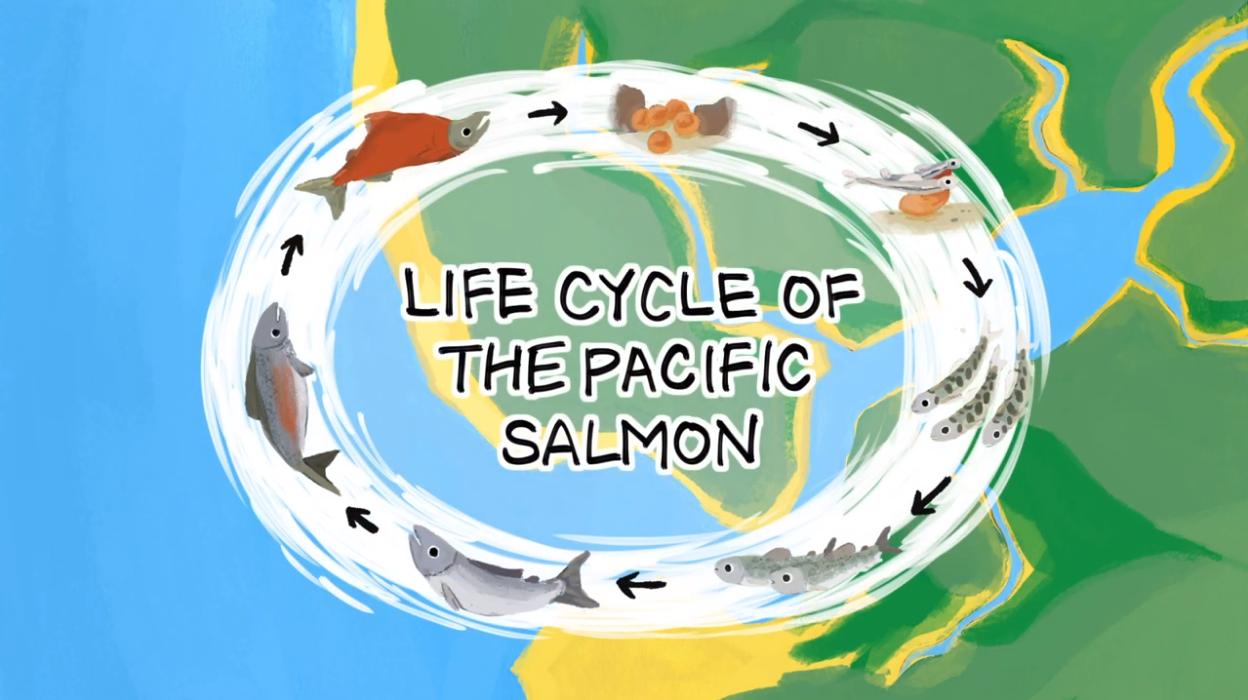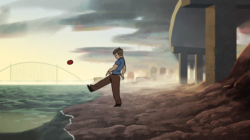
The Mythical Journey of Pacific Salmon
By Rose Bond, Animated Arts Department Head, Pacific Northwest College of Art
What makes a mythic creature? Massive size? Slicing incisors? Fire breath? How about a creature who journeys thousands of miles and, against all odds, makes their way back home? The latter is the story we found compelling, a story that stretches far into the past: the story of the Pacific Salmon.
My name is Rose Bond and I’m the Head of Animated Arts at Pacific Northwest College of Art (PNCA) in Portland, Oregon. I recently had the distinct honor of introducing the virtual premiere of The Life Cycle of the Pacific Salmon. This animated short, supported by the National Marine Sanctuary Foundation, is the result of the latest collaboration between PNCA student artists and the scientists of the National Oceanic Atmospheric Administration – who we know as NOAA Fisheries.
Every year, Pacific salmon migrate from their home streams to the ocean and back again. This journey can span hundreds or even thousands of miles and along the way salmon are playing an important role in the health and stability of ecosystems. They are a vital link in many marine, freshwater, and riparian food chains and a keystone species in many different ecosystems they visit. Throughout their life, Pacific salmon face human-made challenges including climate change, passage barriers, habitat loss, water pollution, and threat of extinction. The film was made to shed light on the importance of salmon and the urgency of addressing the threats they face.
While some may think a partnership between an art school and a federal science agency is an unlikely pairing, we have found otherwise. In 2013 Emily Bosanquet, who taught science at our college, planted and kindled the seeds for PNCA’s Art + Science Initiative. That year, NOAA came knocking and Animated Arts opened the door.
Our first joint project was a short film that thread the needle between waterfront development and the habitat needs of salmon. Working with NOAA Fisheries scientists and administrators, animators Beryl Allee and John Summerson used their skills and vision to frame the challenge, propose alternatives and invite a call to action. Check out an excerpt from our first collaboration – an animated short entitled Habitat.
Through collaborative efforts between art and science, we are finding ways to advance a shared vision – one that bridges environmental science and stewardship with the potent immediacy of the moving image. How long does it take to get across an idea that might change minds and change behavior? Animated by Beryl Allee, this mini-short, entitled Littering, was created in 2015 as part of NOAA’s Citizen of Your Watershed social media campaign. Check out what 18 seconds can do here.
Who knew that in literally 18 seconds, a point could be made – and made without pointing any fingers. The fact is that our society is increasingly screen-based, and it seems the challenges we face seem to become ever more complex and acute. While some may relegate animation to children’s entertainment, it’s becoming a go-to medium in expanded venues, from the performing arts to the sciences.
These partnerships, like our one with NOAA, are important. They give our students opportunities to apply their skills to real world issues and can inspire the production of work that leads to understanding, empathy and social change. From environmental concerns to salmon stewardship, our students are the visualizers, the curious researchers, and the storytellers who are eager to make a difference.
When you ask our student team what they prized most in the whole process of working on the Life Cycle of the Pacific Salmon Project, they don’t say animating. Nope – they give top billing to the research, to working with real scientists, and to a guided visit to the Salmon Center and estuary on Hood Canal.

Animators take field trip to the Salmon Center on Hood Canal as part of their research. Photo: Lucas Marin
At PNCA and in our Animated Arts department, I can say with assurance that we continue to be inspired by our evolving collaborations with the folks at NOAA. Our region and our planet face many challenges. As artists we believe we have a role to play in our communities. With all the challenges, and as an educator, I know how important it is for students to focus. Again, when we ask students what they got from these projects,overwhelmingly they speak to the value of research and their interaction with the scientists and very real first hand observation to do just that.
With this project, I think we’ve added another A to STEM. We believe STEAM is a pathway to the positive changes we need. Without a doubt the National Marine Sanctuary Foundation’s support for this latest project, capping eight years of collaboration under our Arts & Science Initiative, raises the visibility and impact of our joint efforts. And through this partnership, NOAA has developed an array of materials to help teachers enliven and enrich their lessons for our young people, the ones who will carry their understanding of and commitment to stewardship into our future.
I want to credit one outstanding and beloved faculty member: Lori Damiano. Lori D and her dedicated team of student animators and alums worked through COVID restrictions, with all its incumbent angst, to bring this animated short to the greater world community.
For thousands of years tribal people throughout the Columbia Basin have held the salmon in a special place. Their cycle, this story, is a truly mythic journey.
Visit these websites to find more resources to foster stewardship for this iconic species:


